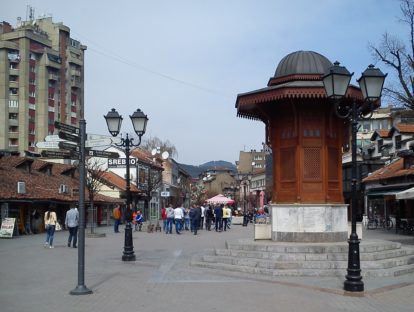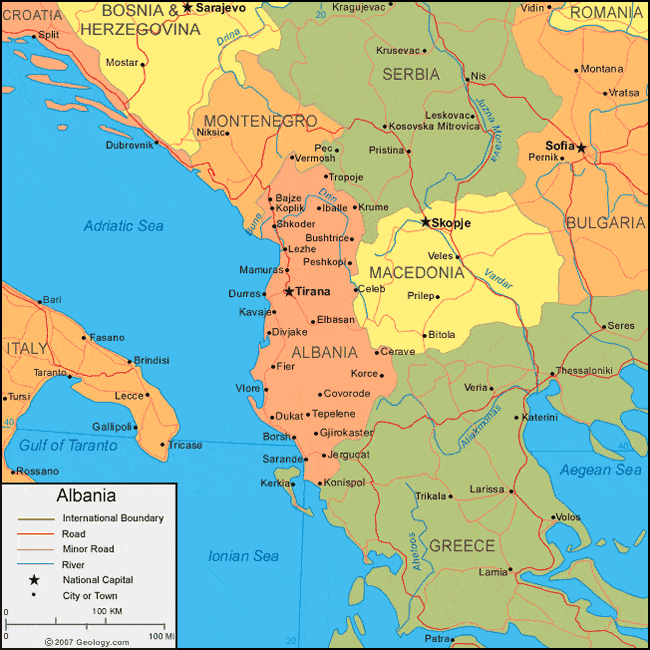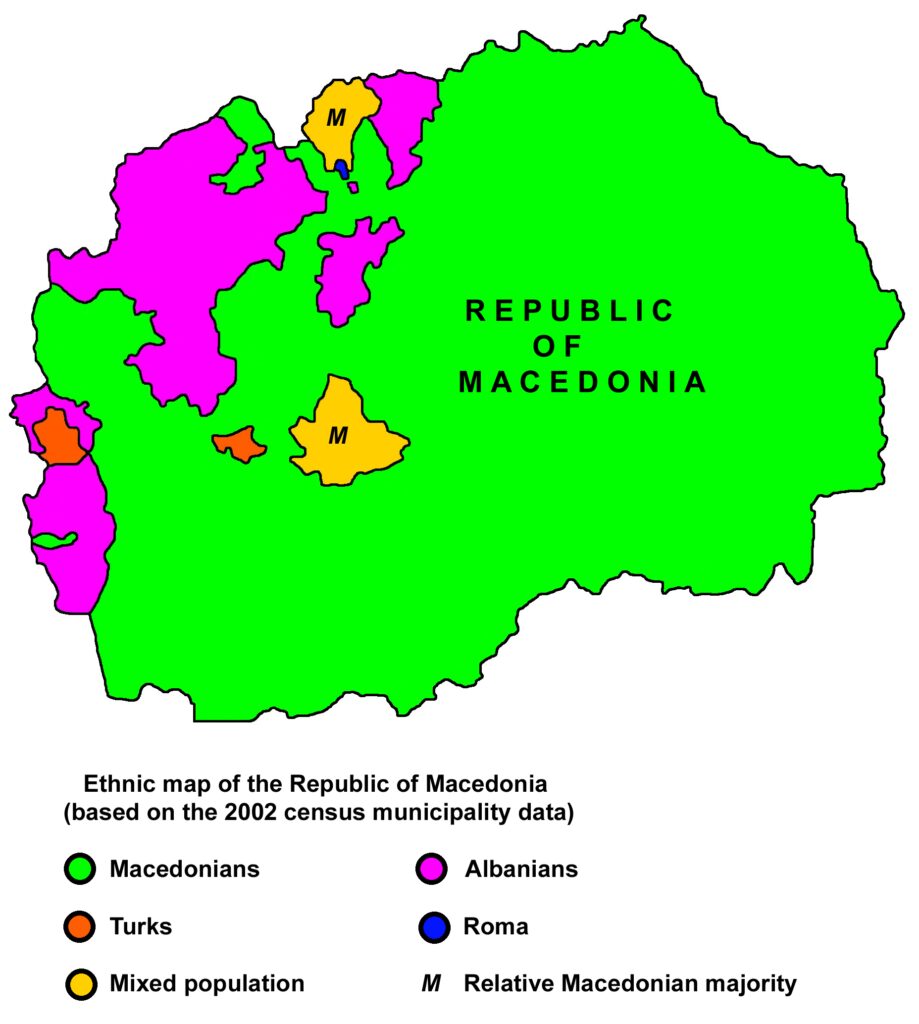
Introduction
In their study De-radicalising the Western Balkans, Tatyana Dronzina and Sulejman Muça (two researchers from Bulgaria) point out that „out of a total of 4000 Europeans who have joined the so-called Islamic State, or ISIS, 900 (approximately one-quarter) originate from the Western Balkans (Albania, Bosnia and Herzegovina, Kosovo and Macedonia)”[1]. In addition, it is estimated that “in Albania, Bosnia, and Kosovo alone, extremists control more than 150 mosques and prayer rooms”.[2] These numbers are alarming and indicate an increasing security threat in the Balkans. Although jihadism is rooted in the Balkans since the 1990s, Balkan states have initiated a process of democratization and Europeanization, thought of as pacifiers of the region, and its religious-ethnic conflicts. The recent resurgence of jihadism in more radical and transnational forms reveals the uncertainties of the Balkans, which have led previously to large scale wars and conflicts.
Contrary to jihadism in Western Europe, and the West in general, which is mainly led by immigrants of the first or later generations, jihadism in the Balkans is local, endorsed by native Muslim populations, deeply related to nationalism and ethnic wars in the region. A second specificity of the region to take into account is its proximity to Turkey, and the geopolitical interest Turkey, supported/or rivalled by Gulf Sunni states such as Saudi Arabia and Qatar, or even sometimes Iran, to sustain political action of Muslims in the Balkans. Jihadism can therefore be seen as the head of a pyramid of a thriving political Islam, legitimate in the eyes of a segment of Muslim populations in the Balkans, especially Kosovo and Bosnia. This does not discard the fact that Muslims in the Balkans are usually diverse and fragmented among several ethnicities, political allegiances and with different ties to Islam, ranging from Sufism to Salafism.
This paper depicts the current status of jihadism in the Balkans, covering Serbia, Bosnia, Albania, Kosovo and Macedonia, and focusing on the fact and figures of jihadi fighters, that is the number of jihadis in each country, the returnees, those killed in the Middle Eastern conflicts, and the jihadi centers and networks in the Balkans, and finally how jihadism is countered in the Balkans.
SerbiaA study by Marija Ristic et al. reported that according to Serbian security services „between early 2012 and January 2016, 50 Serbian Muslims, including women and children, traveled to Syria and Iraq. Some of them belong to the Roma community. Others have been recruited from the Bosniak Muslim population”.[3] Timothy Holman estimated their number to be between 30 and 70 fighters, the number of the killed in the fighting to be 5 while he does not provide any number of the returnees.[4] J. K. Wither reported the number of 25 as of July 2015[5] and a report by the CIA in 2014 states that only three citizens from Serbia are fighting in Syria.[6] A source mentioned by Schmid states that „several dozens” of Serbians fought against Assad in Syria.[7] Finally, Serbia is credited with 60 fighters among the ISIS according to Benmelech and Klor.[8]
The 2017 report on defence and security in Serbia, published by BMI research of the Fitch Group, noted “the still-limited, but growing threat of Islamist militancy in Serbia”.[9] The report also considers Serbia as a potential target for Islamist terrorism „due to its wartime atrocities against Muslims in Bosnia and Kosovo in the 1990s, its proximity to these countries and Albania”.[10] As a response to this increasing jihadist threat, Serbia has charged in 2014 „five men for terrorism over recruiting, financing and transporting fighters for conflict in Syria, joining forces to finance terrorism, train and recruit people for terrorist acts”.[11]
Probably, the source of jihadist threat in Serbia could come from the Sandžak region, and the city of Novi Pazar in particular described by Rusmir Smajilhodzic and Nicolas Gaudichet as “the most deprived area of Serbia and a breeding ground for Islamist extremists”.[12] In 2014, Zoran Maksimovic reported „calls in Novi Pazar for the formation of an Islamic army of Mujahideen to defend Muslims against an alleged threat of violence from Serb nationalists”[13]. Sandžak lies in south-western Serbia, bordering Montenegro, Kosovo and Bosnia and has a majority of Muslim population (60 %), about 142,000 Bosniaks.[14]
BosniaData reported by Dronzina and Muça shows that Bosnia is one of the main regional exporters of jihadists to the Middle East with the number of jihadists ranging between “200 and 330, among of which 50 have been killed, 60 have returned to Bosnia, and 40 have been brought to justice”.[15] Holman, based on a review of press reporting between January 2013 and June 2014, estimates the number of jihadis from Bosnia in Syria to be between 50 and 330, those who were killed to 10-15 men and the returnees to between 32 and 50.[16]
A minority of Muslims in Bosnia adheres to radical views ( 4%)[17], but clusters of radical groups are strongly established in more than 10 villages in the mountains of Bosnia. For example, Gornja Maoča, a village in the north-eastern Bosnia, close to Croatia and Serbia is a stronghold of a radical community of 18 individuals, established by Nusret Imamovic.[18] The Independent reported that “in rural Bosnia, civil war of 1992-1995 and the influx of Mujahedeen fighters sowed the seeds of radical Islamism… unemployment in Bosnia currently at 25.6 per cent, youth unemployment is a staggering 67.6 per cent, the worst in the world according to data published by the World Bank[19]”, In addition, Saudi Arabia, Turkey and Iran exploit the vulnerabilities of Bosnia, offering financial and educational aid, supporting a large network of radical thought and practices throughout Bosnia.[20]
The government in Bosnia attempts to counter jihadism by arresting 11 ISIS members in 2014 in addition of arresting several returnees[21]. Bosnian authorities also discovered large quantity of weapons when they arrested a jihadist in November 2017.[22] The Economist joined the pessimistic camp, depicting in two recent assessments of Bosnia’s security situation in July and October 2017 a rather gloomy image of the future of Islamism, and radical Islamism in Bosnia drawing as well attention to „the growth of Russian and Turkish influence in the region mostly as a consequence of the weakening presence of the EU”.[23]

AlbaniaThe presence of Albanian foreign fighters in the Middle East can already be attested in November 2005 when „Syrian authorities arrested an Albanian national in Damascus on suspicion of being involved with foreign fighter activities”[24]. In 2015-2017, the number of Albanian foreign fighters in the Middle East was estimated between 50 and 148. Holman reported that between January 2013 and June 2014, 50-90 fighters from Albania have travelled to Syria.[25] Adrian Shtuni, on his part, estimated their number to 70[26] in one article and 90 to 148 in another[27] published the same year (2015). An official source in Albania claims that by 2014 „at least thirteen foreign fighters from Albania have travelled to Syria with their wives and thirty-one children”.[28] Holman estimated the number of Albanian jihadists killed in Syria to 6-8 individuals and the returnees to 22-28.[29] Another source cited by Shtuni mentions the number of reported casualties among jihadists from Albania as being twelve.[30] Dronzina and Muça consider that “about 90 Albanians have joined ISIS, with many of them having been killed or gone missing. The names of 30 have already been published by the Albanian press”[31]. Finally, Asllan Dogjani (deputy in the Albanian Parliament) and Arben V. Prifti (lecturer at the Mediterranean University of Tirana) estimate the number of Albanian fighters in Syria to be 80.[32]
The previous sources agree that Jihadism is not widely supported in Albania. However, jihadist movements, by nature, do not appeal to the mass of people, but instead to marginal groups or individuals, with the aim to destabilize states and regions. Some indications could help us assess better the extent of influence of jihadism in Albania. Gordon N. Bardos asserts that “the Facebook page “Krenaria Islame” (Albanian for “Islamic Pride”), which posts pictures and stories of Albanians fighting in Syria, has twenty-five hundred followers”.[33] A Pew Research study on sharia showed that (24%) of Muslims in Albania hold the view that sharia is the divine word of God and that (8%) of Muslims in Albania support killing converts to other faiths[34], which are certainly some of the lowest scores in Muslim majority countries (Albania is (58.79%) Muslim), but still is a concerning matter for a European country. Being a member of the NATO and an official candidate for membership in the European Union, a democratic state, secular and economically viable and growing country, Albania could counter jihadism. For example, it adopted recently a series of measures to counter terrorism, including setting a counter-terror commando unit.[35]

KosovoAlthough the flows between Albania and Kosovo are constant, benefiting from common ethnic ties, Kosovo has a deeper connection with jihadism than Albania, based on a wider spreading of the salafi doctrine, and the open-gate to radical Islamism and Muslim countries, especially Saudi Arabia, during the Kosovo war ( 1998-1999), by Kosovo Muslim communities. Besides, Kosovo is a recent state, and has major ethnic, political and economic fragilities. A police source cited by The New York Times said that between 2014 and 2016, 314 Kosovars — including two suicide bombers, 44 women and 28 children —have gone abroad to join the Islamic State, the highest number per capita in Europe” (Kosovo’s population ins 1.8 million people).[36] The Kosovar Centre for Security Studies, citing Kosovo police sources claimed that 36 women are known to have left the country to live in ISIS -controlled territory, around 60 Kosovars are believed to have been killed in the conflicts and 130 fighters have so far returned home.[37]
In a late February 2015 interview Kosovo’s Minister of Internal Affairs declared that „the number of foreign fighters from Kosovo stands at “about 300”.[38] Between January 2013 and June 2014, Holman estimated their numbers to 80-150 fighters, based on press reporting. The number of killed fighters from Kosovo is according to Holman 12 and the number of returnees is 15.[39] One of these Kosovar fighters, who joined ISIS, had lived in Switzerland, before carrying a terrorist attack, „killing three people and wounded five others, including law enforcement officials, in Nigde, Turkey”.[40]
Fatos Haziri and Enver Buçaj reported in early 2017 that the counter-measures taken by Kosovo police and the Kosovo Special Prosecution Office against 237 persons suspected to have committed the offenses provided under the Criminal Code of organizing and participating in terrorist groups, led to arresting 127 people, including the key persons of the group dealing with recruiting and facilitating the majority of fighters from Kosovo, and sentencing 44 persons arrested for abovementioned offenses with 187 years in prison”[41].
Rudine Jakupi, an analyst at Kosovar Center for Security Studies, explains the popularity of radical Islamism in Kosovo by history and social facts. She traces the radicalization of Kosovo back to a number of social factors, such as poverty, the inadequacy of the educational system, and the identity crisis of young people. Among the reasons of radicalization, she mentioned the entry of foreign Wahhabi views from the Middle East – mostly through Albania – channelled by many NGOs with foreign background, among which there is a significant proportion of Saudi Arabian-funded ones.[42]
MacedoniaAmong the countries of the Western Balkans Macedonia has probably the less number of foreign fighters (6-12 fighters, according to Holman, of which 4-10 were killed in the war).[43] Shtuni also reported a low number of twelve fighters based on press, but he argues that this is very low and instead suggests that „judging from the similar number of reported casualties among jihadists from Albania (twelve) and ethnic Albanian jihadists from Macedonia (fourteen), it would be reasonable to assume that the total number of ethnic Albanian fighters from Macedonia is about 100”.[44] In addition, some five foreign fighters who belong to the ethnic Albanian Diaspora in Western Europe originate from Macedonia.[45] Shtuni quotes another source estimating the number of Macedonians who were killed in Syria to be 14.[46] Another source minimized the importance of foreign fighters in Macedonia citing only 12 fighters who went to Syria in a country whose third of the population is Muslim, representing 0,001% of the population in Macedonia[47]. Haris Fazliu mentions that „over 70 individuals have returned to Macedonia from the conflict zones in Syria and Iraq”.[48] The most comprehensive study to date on jihadists in Macedonia states that there „are 86 fighters who have already returned to Macedonia from the conflict in Syria and Iraq. 11 individuals have been sentenced to jail thanks to Operation Cell 1, while an additional 4 individuals have been arrested in ‘Operation Cell 2’ which took place on July 9th 2016. More than a hundred individuals from Macedonia are still in Syria/Iraq or were killed while fighting”.[49]
Unlike Kosovo and Albania, Macedonia is inhabited by a Muslim minority, which makes these numbers, although low, disturbing. Director of the Intelligence Agency in Macedonia, Zoran Ivanov declared even that „terrorism is the greatest threat in Macedonia” [50] and a court in Kumanovo sentenced 33 people to prison terrorism offences. A fragilising factor for countering jihadism is the fact that the political crisis with the Albanian minority in Macedonia is not over yet, and the ethnic tensions caused by political demands of this minority might provide jihadism with a religious-ethnic frame, in an attempt to gain more support.

Conclusion
We shall conclude by assessing the threat of jihadism in the Western Balkans, from the perspective of Hungary. First of all, seen from Hungary, jihadism might seriously endanger the process of political reconciliation in the ex-Yugoslavia countries, especially in Serbia, Bosnia and Macedonia. Jihadism could reactivate the ethnic-religious tensions between Muslims and non-Muslims in the three countries, leading to similar bloody conflicts the region got bogged in during the 1990s. It is, therefore, expected that Hungary, as an EU and NATO member would collaborate with the Western Balkan countries in order to achieve full reconciliation and construction of peaceful nations. Another threat of jihadism could be that of opening routes for mass migration. For Hungary, establishing the fence and protecting its southern borders from illegal migrants through the Balkan route is a strategic priority. There is a firm determination to carry on this policy, supported by the Visegrád group (Czech Republic, Poland, and Slovakia). Finally, Hungary observes closely the jihadist sphere in the Western Balkans with regard to terrorism, organised in local networks (in the Western Balkans) or beyond. Hungary lies in the mid-way between the Balkans and Western Europe, which could facilitates the transit of terrorists, weapons and false documents from the Balkans to Western Europe, or the other way around, and has joined efforts with other partners in Europe and the region to counter-terrorism.
